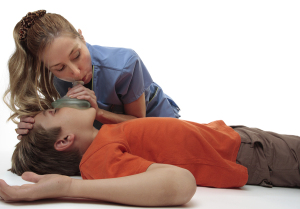Complex partial seizures cut the patient off from the surrounding environment for about 1 or 2 minutes.
The patient may utter unintelligent sounds without a meaning, may have a blank stare or perform complex, purposeless hand gestures. During this time the patient would resist aid and this can cause problems, if the surrounding crowd does not understand that this is a seizure and is beyond the control of the patient.
Following this partial seizure there is a 1 to 2 minute recovery period (post-ictal phase) where the patient is awake, but is mentally confused. Often these seizures originate from the temporal lobe (epilepsy lobe temporal), but they can originate anywhere in the brain and EEG’s are necessary for investigation. Also, as there is a higher incidence of tumors such as low grade astrocytomas, an MRI scan should be performed.
These patients have a higher incident of mental problems with about 1/3 having psychological problems between seizures and about 10% having schizophrenic or depressive psychotic episodes.
Ref.3 explains that in the post-ictal phase of temporal lobe seizures an animal model confirms the observation in humans that disruptive behavior seems to be associated with this state.
The authors concluded that the changed behavior comes from the seizures, which changed the neuronal processing in the affected temporal lobe and the connecting subcortical structures.
Treatment
Lamotrigine (brand name: Lamictal) is used to control complex partial seizures. Gabapentin (brand name: Neurontin) may have to be added on. On the other hand Yen et al. (Ref.4) have shown that topiramate (brand name: Topamax) when added onto the existing anti-seizure medication, can significantly improve uncontrolled temporal lobe seizures.
References:
1. F Zara et al. Am J Hum Gen 2000 May 66(5): 1552-1557.
2. S Yeung et al. Europ J Paediatr Neurol 2000; 4(1): 31-33.
3. LS Leung et al. Neurosci Biobehav Rev 2000 Sep 24(7): 763-775.
4. DJ Yen et al. Epilepsia 2000 Sep 41(9) 1162-1166.
5. E Starreveld et al. Can Fam Physician 2000 Sep 46: 1817-1823.
6. The Merck Manual, 7th edition, by M. H. Beers et al., Whitehouse Station, N.J., 1999. Chapter 172.
7. The Merck Manual, 7th edition, by M. H. Beers et al., Whitehouse Station, N.J., 1999. Chapter 271, p.2415.
8. Ferri: Ferri’s Clinical Advisor: Instant Diagnosis and Treatment, 2004 ed., Copyright © 2004 Mosby, Inc.
9. Rakel: Conn’s Current Therapy 2004, 56th ed., Copyright © 2004 Elsevier







